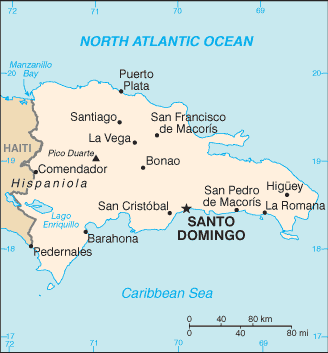Map:

Overview:
Explored and claimed by Columbus on his first voyage in 1492, the island of Hispaniola became a springboard for Spanish conquest of the Caribbean and the American mainland. In 1697, Spain recognized French dominion over the western third of the island, which in 1804 became Haiti. The remainder of the island, by then known as Santo Domingo, sought to gain its own independence in 1821, but was conquered and ruled by the Haitians for 22 years; it finally attained independence as the Dominican Republic in 1844. In 1861, the Dominicans voluntarily returned to the Spanish Empire, but two years later they launched a war that restored independence in 1865. A legacy of unsettled, mostly non-representative, rule for much of its subsequent history was brought to an end in 1966 when Joaquin BALAGUER became president. He maintained a tight grip on power for most of the next 30 years when international reaction to flawed elections forced him to curtail his term in 1996. Since then, regular competitive elections have been held in which opposition candidates have won the presidency. The Dominican economy has had one of the fastest growth rates in the hemisphere over the past decade.
The People:
Population: 8,950,034 (July 2005 est.)
Age structure:
0-14 years: 32.9% (male 1,505,964/female 1,438,809)
15-64 years: 61.7% (male 2,815,544/female 2,703,012)
65 years and over: 5.4% (male 226,372/female 260,333) (2005 est.)
Religions:
Roman Catholic 95%
Government Type:
representative democracy
Leader(s) to pray for:
chief of state: President Leonel FERNANDEZ Reyna (since 16 August 2004); Vice President Rafael ALBURQUERQUE de Castro (since 16 August 2004); note - the president is both the chief of state and head of government
Source: The World Factbook
View All Countries